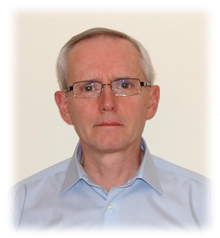60 Garden Street, Cambridge, MA 02138
|
|
|
Harvard-Smithsonian Center for Astrophysics
60 Garden Street, Cambridge, MA 02138 |
 |
Thomas M. Dame
Senior Radio Astronomer Lecturer on Astronomy |
|
Research Interests My observational work is mainly carried out with the CfA 1.2 meter telescope and is geared toward determining the distribution and properties of dense, star-forming molecular clouds throughout the Milky Way Galaxy. A major milestone of this work was the publication in 2001 of a Complete CO Survey of the entire Galactic plane. As Director of the CfA's Radio Telescope Data Center, I recently made all of this survey data available on-line. As of 2013, our unbiased CO survey covers nearly the entire Northern sky with sampling of 1/4-deg or better; a recent coverage map is available here. Much more information on the telescope and our group's research accomplishments is given on the millimeter-wave group site. My research focuses on applying our extensive CO survey to a broad range of Galactic studies, including Galactic spiral structure and star formation, the distribution and origin of cosmic rays, the structure and evolution of supernova remnants and compact objects, and the stellar mass distribution inferred from the near-infrared. Over the past few years I have used our CO observations to identify two major new spiral features of the Milky Way, one a long-sought counterpart of the so-called Expanding 3-kpc Arm and the other possibly a distant extension of the Scutum-Centaurus Arm and a symmetric counterpart of the nearby Perseus Arm. A few informative links on these recent results are given below.
Since 2009 I have been working with Mark Reid and an international team in an effort to measure parallax distances and proper motions of masers in several hundred high mass star forming regions in the Milky Way. The BeSSeL project (Bar and Spiral Structure Legacy Survey) has been awarded over 5,000 hours of observing time on the Very Large Baseline Array between 2010 and 2015, the largest time allotment ever for a single project on that facility, and so far maser distances and proper motions have been measured in over 100 star forming regions. The ultimate goals of this project are to trace out the Milky Way's spiral structure and make accurate measurements of its overall size and motions. Publications From ADS abstract and article database. My most well-known "publication" just might be this poster! Teaching I have been involved in the course Astronomy 191: Laboratory Astrophysics since shortly after it was first offered in 1988. In addition to teaching one or more of the core experiments involving the CfA 1.2 meter telescope, I work with John Kovac and Pat Thaddeus on overall course planning and handle most of the course administration. I also teach a laboratory in the course Astronomy 17: Galactic and Extragalactic Astronomy. In the laboratory, students use the 1.2 meter telescope to measure the velocities of molecular clouds along the plane of the Milky Way, and from these data derive the Galactic rotation curve and total Galactic mass within the Sun's orbit. This is a required course for Astronomy concentrators. My Astronomy Department webpage Committees and other Service Director, Radio Telescope Data Center |